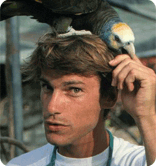Parrot Corridors and Conservation

Jamie, I have been studying the Parrot Action Plan, trying to find a way to help the WPT with the small amount that I have to donate. I have a few questions for you:
2.) This question pertains to page 100 of the Parrot Action Plan. I’m going to quote a portion of it for other readers of this message:
“Parrot biologists can help to identify critical linkages in habitat connectivity for species facing severe habitat fragmentation. ...the current multi-national effort to implement the Mesoamerican Biological Corridor in Central America should maintain and in some cases, create, key linkages for habitat connectivity.
Brazil’s recent strategic plans to establish a network of biological corridors between protected areas may advance conservation possibilities for severely threatened parrots… ...increasing both the connectivity between reserves as well as the altitudinal representation of mosaics of important habitats. Since most Andean reserves were historically designed with altitudinal lower limits, many parrot species appear to be suffering from lack of continuous altitudinal habitats for seasonal foraging or reproductive migrations.”
The Vinaceous Amazon comes to mind here because they only exist in isolated pockets of habitation right now. They are endangered and I’m afraid that they will be extinct in the wild soon if something like this isn’t done. This bird is being bred now in the USA for the pet trade, but that isn’t going to help the indigenous parrots who may end up going the way of the Spix’s Macaw.
So my question is this: Is this the smartest place to donate money to help parrots in the long run? (For the establishment of some flight corridors.) Or, would it be wiser to donate to the WPT and allow them to make the best choices? I’m thinking here of the future of parrots in general, and survival for the most species possible.
My first thought about where to donate this money was toward the Patagonian Conure project. If it would be possible for the WPT to actually buy up those cliff sites and some surrounding land, just think what it would do for that species. I have 3 Patagonian conures right now and I adore them. I understand that their habitat is becoming more and more threatened.
Cindi Eppers

Dear Cindi,
I think that’s maybe several questions in one! You’re right that the remaining Vinaceous Amazons are distributed in patches and have suffered a great deal of habitat loss. They are also targets of the illegal trade, primarily for the domestic markets in Brazil, Paraguay, and Argentina. Aiding the recovery of this species is unfortunately not as straightforward as buying or restoring habitat between these patches, and there may even be movements among some of the patches which would negate the value of such corridors, at least for the parrots. Moreover, working on supporting enforcement of existing laws, educational campaigns, and other efforts to protect the birds in the wild may be the most cost effective and rapid way to support the recovery of this species.
Over the past 20 years, we’ve come to understand that there are a number of really important components in any successful conservation project, and chief among them is the presence of a local researcher or NGO which is competent and enthusiastic about saving the species. Where I think we can be very helpful at the Trust, is working through our networks of researchers, identifying collaborators who are going to get the job done, then doing our best to provide them with the funds, tools, and technical support to make the project a success. Asking these kinds of questions is a GREAT place to start, as we can help give you a sense for where we think such support can be most effectively spent, both in terms of geography and in terms of the species in question.
For the Patagonian Conures, it’s not possible to buy El Condor itself, and there is a great chance that it will receive full protection very shortly. On the other hand, there may be other colonies where a land purchase (or other creative arrangement) may be possible, and it may make a big difference in the end. That said, one of the primary threats to this species was the widespread and LEGAL harvesting of this species for the European pet trade. As this has now stopped, the Argentine government is no longer allowing thousands of these birds to be taken from the wild each year.
All best wishes,
Jamie

































